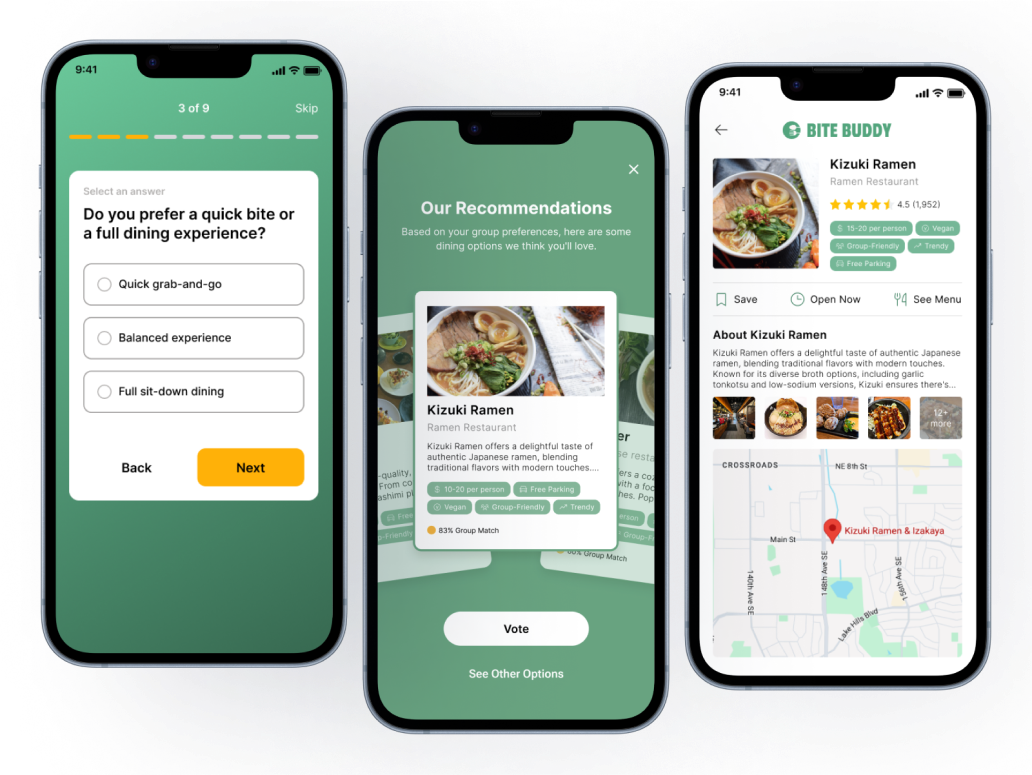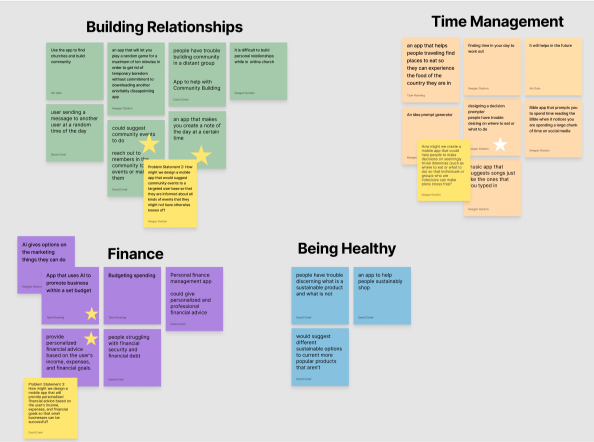December 2024
Bite Buddy: A UX Case Study and Product Vision

Mobile App Concept
Project Brief
My Roles
UX Research
UI/UX Design
Branding
Product Strategy
Originally created to simplify group dining decisions, Bite Buddy uses AI to recommend restaurants that suit everyone’s tastes. The concept was revisited to test its usability and clarity with real users, revealing opportunities to improve flow and engagement. Insights from testing informed a redesigned experience that feels more intuitive and collaborative.
Client
Class Professor
Role
Research and Design
Date
Dec 2024 – Jan 2025
The Problem
Deciding where to eat as a group often leads to frustration, indecision, and wasted time.
Bite Buddy was created to address the common challenge groups face when choosing a restaurant that satisfies everyone’s preferences. Developed as part of a class challenge in a UX Design Methods course at Northwest University, the project applied UX principles to simplify group decision-making and create a more enjoyable, stress-free dining experience.

Discovery Process
This was a discovery-focused project that unfolded in multiple stages, each aimed at understanding user needs and refining the concept through research, analysis, and iteration.
Process:
Persona Creation
Empathy Mapping
Journey Mapping
Storyboarding
Presentations & Critiques
Brand Development
The (Initial) Solution
We concluded the exploration phase by developing low-fidelity wireframes that outlined an initial user flow. While this marked the end of the discovery process, it surfaced valuable ideas that guided future design directions.
-1.png)
Learnings & Insights
- This project reinforced the value of iteration, collaboration, and design intent.
- Learned how integral feedback is to refining ideas and identifying recurring pain points that needed clarity or improvement.
- Discovered how personas and scenarios anchor design decisions and clearly communicate who and what the product is for.
- Gained experience leading a design team, encouraging each member to present their strengths and contribute meaningfully throughout critiques and presentations.
Future Thinking
If given more time and fewer constraints, Bite Buddy could expand its capabilities.
- Smarter AI integration: Scan restaurant menus for specific needs (like vegan or allergy-friendly options) and partner with services like DoorDash or Uber Eats.
- Enhanced engagement: Add light gamification and a community feature where users share reviews and connect over shared tastes.
- This project reinforced the value of iteration, collaboration, and design intent.
- Learned how integral feedback is to refining ideas and identifying recurring pain points that needed clarity or improvement.
- Discovered how personas and scenarios anchor design decisions and clearly communicate who and what the product is for.
- Gained experience leading a design team, encouraging each member to present their strengths and contribute meaningfully throughout critiques and presentations.
Future Thinking
If given more time and fewer constraints, Bite Buddy could expand its capabilities.
- Smarter AI integration: Scan restaurant menus for specific needs (like vegan or allergy-friendly options) and partner with services like DoorDash or Uber Eats.
- Enhanced engagement: Add light gamification and a community feature where users share reviews and connect over shared tastes.
Project Re-Opened
To align the study with both user and business goals, I synthesized guiding questions such as:
- How do users engage with Bite Buddy’s group features?
- What usability barriers impact satisfaction and success?
- How can the product better support group decision-making and reduce indecision?
These questions helped bridge UX research and product strategy, ensuring findings could directly inform both design and business outcomes.
- How do users engage with Bite Buddy’s group features?
- What usability barriers impact satisfaction and success?
- How can the product better support group decision-making and reduce indecision?
These questions helped bridge UX research and product strategy, ensuring findings could directly inform both design and business outcomes.
To align the study with both user and business goals, I synthesized guiding questions such as:
- How do users engage with Bite Buddy’s group features?
- What usability barriers impact satisfaction and success?
- How can the product better support group decision-making and reduce indecision?
These questions helped bridge UX research and product strategy, ensuring findings could directly inform both design and business outcomes.
- How do users engage with Bite Buddy’s group features?
- What usability barriers impact satisfaction and success?
- How can the product better support group decision-making and reduce indecision?
These questions helped bridge UX research and product strategy, ensuring findings could directly inform both design and business outcomes.
The Research
I conducted in-person usability sessions using a paper prototype to observe how participants interacted with the app in real time. Each session followed a moderated, think-aloud format, allowing me to capture user attitudes, first impressions, and points of confusion throughout the experience. All sessions were recorded for later analysis, ensuring that both behavioral patterns and qualitative feedback were captured accurately.
After completing the sessions, I synthesized the findings into a detailed usability report outlining key insights, usability issues, and actionable design recommendations. I then presented this report to my class, showcasing how user feedback could directly inform future design iterations and improve overall product usability.
The Re-design
Building on the research insights, peer feedback, and instructor guidance, I applied my growing UX and visual design skills to develop a redesigned version of the app. The updated design directly addressed the key usability pain points identified during testing—improving navigation clarity, reducing user friction, and enhancing overall decision-making flow.

Learnings and Takeawys
- The value of early testing: Even with a low-fidelity paper prototype, usability testing revealed critical navigation and comprehension issues that would have been harder to catch later in the process.
- Importance of structured moderation: Facilitating in-person sessions taught me how to guide participants effectively balancing neutrality while prompting valuable insights through the think-aloud protocol.
- Bridging research and product goals: By framing research questions around both user behavior and business impact, I learned how to connect usability findings to tangible product opportunities.
- Importance of structured moderation: Facilitating in-person sessions taught me how to guide participants effectively balancing neutrality while prompting valuable insights through the think-aloud protocol.
- Bridging research and product goals: By framing research questions around both user behavior and business impact, I learned how to connect usability findings to tangible product opportunities.